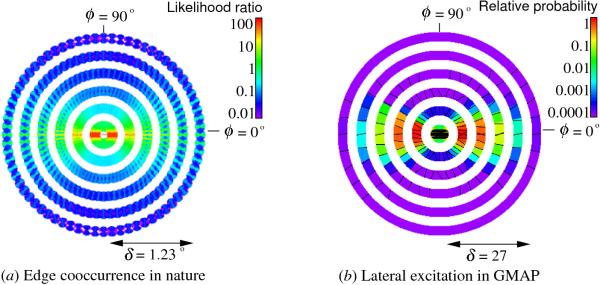
Click on the image to see a PDF version (for zooming in)
Fig. 13.9. Edge cooccurrence in nature and long-range lateral
connections in PGLISSOM. The distributions of excitatory lateral
connections in the model are compared with the edge-cooccurrence
statistics in nature to see how well they match perceptual
requirements. (a) The Bayesian edge-cooccurrence statistics in natural
images (Geisler et al. 2001; reprinted with permission, copyright 2001
by Elsevier). Each location in polar coordinates (&phi, &delta)
contains a small round disk, representing the likelihood ratios of all
possible orientations &theta at direction &phi and distance &delta by
color coding; the &theta with the highest ratio is shown in the
foreground (&theta, &phi, and &delta are defined as in Figure
13.8). Each likelihood ratio represents the conditional probability
that a pair of edge elements in configuration (&theta, &phi, &delta)
belongs to the same physical contour vs. different physical contours
in natural images. The conditional probabilities were determined
through manual labeling of contours in real world images. The most
likely elements are aligned along cocircular paths emanating from the
center. (b) The distributions of &theta, &phi, and &delta for the
lateral excitatory connections in GMAP (Choe and Miikkulainen 2004;
reprinted with permission, copyright 2004 by Springer). Each location
(&phi, &delta) displays two values: (1) The color scale in the
background shows the relative log-probability of finding a target
receptive field at that location, and (2) the black oriented bars
represent the most probable orientation &theta of the target receptive
field at that location (not plotted for the weakest connections). The
figure shows that neurons with receptive fields aligned on a common
smooth contour are most likely to be connected with lateral excitatory
connections. This distribution corresponds closely to the edge
cooccurrence patterns in nature, suggesting that the model is well
suited for encoding grouping relations in natural images.
|